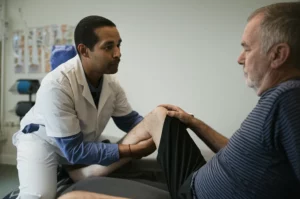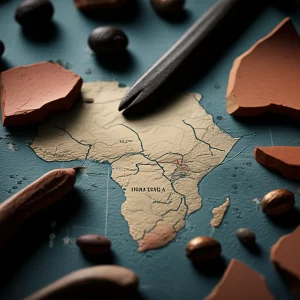Time Travelers: Unlocking Dunhuang’s Ancient Textiles with Science
Hey there! Let me tell you about something truly fascinating – stepping back in time, not with a machine, but with science and some seriously old fabric. We’re talking about textiles found in a hidden cave near Dunhuang, China, dating back over a thousand years. These aren’t just dusty rags; they’re vibrant pieces of history, telling tales of the Silk Road, incredible craftsmanship, and global connections.
Imagine this: a cave sealed up for centuries, creating the perfect time capsule. That’s what happened at the Mogao Grottoes. When Cave 17 was discovered in 1900, it was like opening a treasure chest of manuscripts, paintings, and textiles, preserved in conditions that organic materials usually only dream of. These treasures ended up in museums worldwide, including the British Museum, where our story really kicks off.
Now, these textiles, while amazingly preserved, have seen better days. Colors fade, fibers get fragile. But thanks to some brilliant minds and cutting-edge technology, we’re not just looking at them; we’re *understanding* them, down to the very molecules of the dyes used. And the ultimate goal? To bring them back to life, not just digitally, but through physical reconstruction, using the same materials and techniques the original artisans would have used. It’s like reverse-engineering history!
The Dunhuang Treasures
The discovery of the ‘Library Cave’ at Mogao Grottoes was a game-changer for anyone studying Chinese and Central Asian history. The dry, low-oxygen environment inside kept everything remarkably intact after it was sealed way back in the 11th century. We’re talking about textiles from the 8th to 9th century CE here – mind-blowing!
These fabrics aren’t uniform; they’re a mix of techniques and materials, reflecting Dunhuang’s role as a bustling multicultural hub on the Silk Road. People from all directions were coming through, bringing their skills, materials, and dyeing secrets. The textiles show off a dazzling array of dye sources, far more than earlier periods, proving just how much knowledge and materials were being exchanged.
But even with incredible preservation, time takes its toll. Some dyes, like safflower or sappanwood, are really sensitive to light. This is super important, not just for figuring out how to display these fragile pieces safely, but also for imagining what they looked like originally. They were likely much brighter and more colorful than they appear today.
Peeking Beneath the Surface: The Scientific Toolkit
So, how do you figure out the secrets of a thousand-year-old piece of fabric without destroying it? You use science! The team started with non-invasive techniques – stuff that doesn’t require taking samples.
- Digital microscopy: Getting up close and personal, measuring thread thickness, seeing weave patterns, and spotting tiny details.
- Broadband multispectral imaging (MSI): Taking pictures in different light wavelengths (UV, visible, infrared). This can reveal hidden patterns, show dye distribution, and even make some dyes glow (luminescence!), giving clues about their type.
- Fibre optic reflectance spectroscopy (FORS): Shining light on the fabric and measuring what bounces back. Different dyes and materials have unique spectral fingerprints.
- X-ray fluorescence spectroscopy (XRF): Zapping the fabric with X-rays to see which chemical elements are present, especially useful for identifying metal threads or mordants (chemicals used to help dyes stick).
These non-invasive methods are crucial, especially for areas that are too fragile or too central to sample. They help build a picture and decide where minimal sampling might be necessary.
When a closer look was needed, micro-invasive techniques came into play. We’re talking *tiny* samples, usually taken from edges or already damaged spots:
- Scanning electron microscopy coupled to energy dispersive X-ray spectroscopy (SEM-EDX): Super high-magnification imaging (seeing the fibers themselves!) combined with elemental analysis. Great for confirming fiber type and identifying mordants or metal compositions.
- High pressure liquid chromatography – diode array detector tandem mass spectrometry (HPLC-DAD-MS/MS): This is the big one for dye identification. It separates the different molecules in a dye extract and identifies them based on their mass and how they break apart. It’s like taking the dye apart piece by piece to see what it’s made of.
By combining all these methods, the researchers could gather a huge amount of technical data – the type of fibers, how they were spun and woven, the dimensions, the specific dyes used, the mordants, and even signs of degradation or repair.
Unraveling the Threads: What Science Revealed
The analysis of the three textiles (known by their collection numbers MAS.857, MAS.858, and MAS.876/877) was incredibly revealing. For MAS.857, an embroidered piece, microscopy showed the weave structure, thread sizes, and how the embroidery and metal threads were applied. XRF confirmed the silver threads were mostly silver, possibly applied with a mercury amalgam (fascinating!), and the gold threads were indeed gold, likely with an organic adhesive. MSI revealed the distribution of dyes and even hinted at light-sensitive yellows glowing under UV light.
HPLC analysis confirmed a whole palette of dyes. We’re talking plant-based wonders like sappanwood (red/pink), smoketree (yellow/brown), Chinese cork tree (a bright yellow that often luminesces), pagoda tree (yellow), gromwell (purple), and indigoid dyes (blue/green, source often hard to pinpoint). They also found safflower (red/orange), a known light-fader.
Two discoveries were particularly exciting. For the first time in Dunhuang textiles, they found Turmeric! This yellow dye, common elsewhere in Asia, appearing here around the 8th-9th century is a cool piece of the puzzle about trade and knowledge spread. Also, identifying Larkspur in the samite textile (MAS.858) was a big deal because larkspur is a classic Central Asian dye. Finding it in a textile with a pattern considered ‘foreign-style’ strongly supports the idea that this specific piece was made in Central Asia, not China. Science helping pinpoint provenance – pretty neat!
They also encountered a bit of a mystery: a red dye in MAS.857 that didn’t match anything in their databases of known Asian dyes. Its molecular structure was unusual, suggesting it might be a previously unidentified source of red. More detective work needed there!
The analysis also spotted restoration work. Some couching stitches weren’t original silk but synthetic fibers dyed with modern synthetic dyes (like Acid Yellow 63). Science can even tell us about the history of conservation!

For MAS.858, a sutra wrapper with samite and tapestry sections, the analysis confirmed the different materials (hemp band, plain silk, silk samite, silk tapestry). MSI was super useful here, especially for the tapestry, showing different yellow dyes that looked similar in visible light but glowed differently under UV, helping map their distribution for reconstruction.
The plain silk fabric underneath the wrapper showed signs of being originally pink/orange. Analysis confirmed a mix of sappanwood and turmeric – again, that first identification of turmeric! The samite border’s light orange areas also had turmeric, mixed with safflower red. These combinations explain the faded state today, as these dyes are very light-sensitive.
The tapestry sections (kesi) revealed more dyes: gromwell for purple, smoketree for some browns, Chinese cork tree for a luminescent yellow, and pagoda tree for a non-luminescent yellow. The variety of dyes and techniques in just these three textiles is astounding.
SEM-EDX helped confirm fiber types (silk, hemp) and provided clues about mordants. Aluminum was indicated in several colors (yellow, red, green), and iron was potentially used with smoketree to get brown shades – a clever dyeing trick!
MAS.876/877, fragments of a clamp-resist dyed banner, showed the pattern created by this complex technique. Microscopy measured the design elements, crucial for recreating the carving blocks. Analysis confirmed Chinese cork tree for yellow and sappanwood for orange (originally redder). The layered dyeing process of clamp-resist dyeing (applying colors sequentially while blocking others) was also illuminated by the dye analysis.
Bringing the Past Back to Life: The Reconstruction Process
Okay, so you have all this incredible scientific data. Now what? The real challenge begins: reconstructing the textiles physically. This isn’t just about copying; it’s about understanding the craft, the feel, the weight, and especially, the original colors.
Recreating the exact original color is tricky. Dyes fade, and the precise shade depends on the dyeing recipe, the water, the mordant, and the dyer’s skill – things chemical analysis alone can’t fully capture. So, the team used a mixed approach: trying to recreate the likely original color when the evidence was strong (like faded sappanwood) but sometimes sticking closer to the current appearance when there was more uncertainty. It’s about making a *reasonable approximation* based on the best available data.
For the embroidered textile (MAS.857), they didn’t try to replicate the complex damask base fabric but used plain silk. The focus was on the embroidery itself. They created detailed line drawings based on the analysis, showing every stitch. Then, using silk threads dyed with natural dyes identified by science (or approximations when the exact dye was unknown, like using sappanwood for the mysterious red), they started stitching. Metal threads were sourced to match the gold and silver outlines. It was a painstaking process, comparing test samples to the original and adjusting until it felt right.

Reconstructing the samite border of MAS.858 was a whole different beast. Samite is a complex weave. Based on thread measurements and weave structure, they selected appropriate silk threads. The pattern (those cool confronting lions) was mapped out. Crucially, they had to reconstruct a loom based on Central Asian models (like the Iranian Zilu loom), adapted for the specific samite technique. This hands-on weaving process revealed the ‘intelligence of the hand’ – the practical knowledge embedded in the craft itself. Dyeing the silk for the samite used the identified natural dyes (turmeric, safflower, Chinese cork tree, indigo), though they had to substitute Chinese cork tree for the unavailable larkspur in the green areas.
Finally, the clamp-resist dyed banner (MAS.876/877) reconstruction involved recreating the carved wooden blocks. Maple wood was used, carving the pattern and drilling holes for the dye to reach the fabric. Silk fabric, pre-mordanted with alum, was sandwiched between the blocks and clamped tight. Then came the layered dyeing process: blocking off areas, immersing in dye baths (Chinese cork tree yellow, sappanwood red, indigo blue), and repeating. Green was created by dyeing indigo over yellow areas. The replica, while not a perfect color match (natural dyes are tricky!), successfully recreated the full pattern and gave invaluable insight into the technique.
More Than Just Fabric: Why This Matters
This project is about so much more than just making pretty copies of old textiles. It’s a powerful way to:
- Preserve knowledge: By physically recreating the textiles, researchers and artisans are relearning and preserving ancient craft techniques that might otherwise be lost.
- Understand history: The materials, dyes, and techniques used tell us about trade routes, cultural exchange, and the daily lives and skills of people over a thousand years ago. The identification of turmeric and larkspur, for instance, directly speaks to connections with South and Central Asia.
- Engage the public: Reconstructions make these ancient objects relatable and understandable. Seeing a vibrant replica helps people appreciate the original beauty and complexity in a way that looking at a faded fragment might not. It brings the history to life.
- Inform conservation: Understanding which dyes were used and how they degrade helps museums make better decisions about how to display and care for these fragile artifacts.
It’s a beautiful collaboration between scientists, textile historians, and skilled artisans. The science provides the blueprint, the history provides the context, and the craft brings it into physical being. While recreating the exact past is impossible, these efforts give us the closest look yet at the incredible textile heritage of Dunhuang and the vibrant, interconnected world of the ancient Silk Road.
Source: Springer







